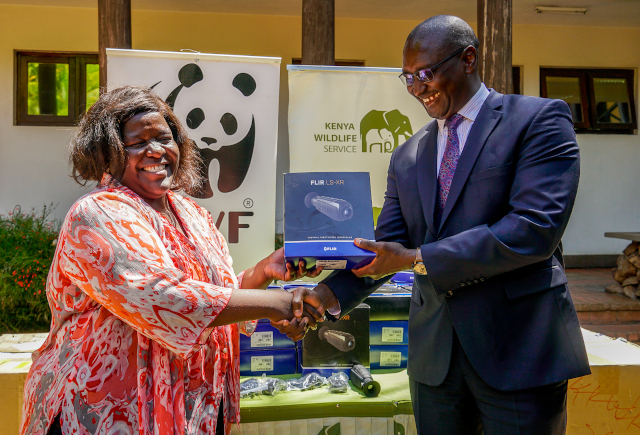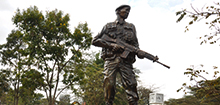
Date Published:
KWS fulfills her conservation mandate, in part, by collaborating with several conservation-oriented organizations. This was showcased when KWS Director General, Brig. (Rtd.) John Waweru, received surveillance and security equipment from WWF Kenya’s Conservation Director, Catherine Ndegwa, on February 10, 2020, at KWS headquarters.
As the rarest of the three remaining black rhino sub-species, the eastern black rhino is listed as Critically Endangered. Kenya hosts over 80% of this remaining population in ‘sanctuaries’ which offer better protection from poaching, which, despite the heavy investment in law enforcement, remains the biggest threat to the sub-species.
In 2015, WWF, in collaboration with KWS and FLIR Systems, installed fixed FLIR thermal sensors along a 9km high-risk section of the boundary of Lake Nakuru National Park (LNNP), a key black rhino sanctuary.
FLIR Systems, Inc. designs, develops, manufactures, markets, and distributes technologies that enhance perception and awareness. They bring innovative sensing solutions into daily life through their thermal and visible-light imaging, video analytics, measurement and diagnostic, and advanced threat detection systems.
The system uses human recognition software (AI) to monitor park boundaries, sending real-time video from the sensors back to the operations room. An alarm alerts KWS staff when a human or vehicle is detected. Poaching at LNNP fell significantly with the apprehension of several would-be poachers when attempting to breach the park’s boundaries.
Based on this success, WWF, in partnership with FLIR systems, committed to upscale their support to 10 rhino sanctuaries across Kenya under the Kifaru Rising Project with the aim of supporting Kenya to work towards the ultimate goal of zero poaching of rhinos.
The project will be implemented in high priority parks and reserves proposed by KWS, including, but not limited to: Lake Nakuru, Meru, Nairobi, Ruma and Tsavo National Parks; Masai Mara and Solio Reserves and Ol Pejeta and Ol jogi conservancies.
This project aims at donating top of the range thermal imager surveillance equipment worth $3 million from FLIR System over the next three years, to the 10 rhino sites.
Several milestones have been achieved since January 2018, when the Vice President of FLIR, Frank Jeff, visited Lake Nakuru Park to evaluate the impact of FLIR equipment in curbing poaching since their deployment in 2015. The latest achievement was in January 2020, when 35 rangers were trained on the use, proper handling and maintenance of the handheld FLIR equipment at KWS Law Enforcement Academy. Ten of the rangers underwent TOT course, as well.
Brig. (Rtd.) John Waweru, expressed his appreciation for WWF’s donation of the state-of-the-art equipment. He stated that he had seen similar equipment in LEWA and hoped that KWS rangers using it would have access to portable solar panels, like they did at LEWA. He wondered whether there was a way of downsizing the bureaucracy involved in the equipment changing hands, to allow for much-needed equipment to reach their end-users in the fastest time possible.





